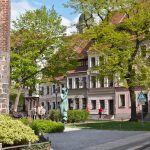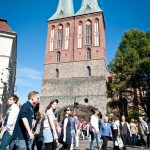The Nikolaiviertel is a special place. For us, who live or work here anyway, but also for the visitors to Berlin, who only a few steps from Alexanderplatz feel as if they have been transported back in time. The quarter also has an extraordinary position because it was rebuilt after the extensive wartime destruction for the 750th anniversary of Berlin in 1987. On the adapted city plan of the pre-war period, a “traditional island” was created around the rebuilt St. Nicholas Church, made up of replicas of historically prominent buildings such as the Ephraim Palace, the Zum Nußbaum restaurant, the Lessinghaus or the court arbor, which once existed there or at other locations in Berlin-Mitte had stood. The fact that replicas stand next to old original buildings in intimate harmony separates opinions. But it is precisely the mix that makes the district so unique and, for those interested in history, a testament to history. Reason enough for the State Monuments Office to give the Nikolaiviertel a very special rating. It has been on the Berlin State Monument List since January 2018.
The senator responsible for the state monument office, Klaus Lederer (Linke), said: “The Nikolaiviertel has high urban planning, architectural and artistic value as evidence of a rethinking of urban and architectural development in the last few years of the GDR. It is comparable to the IBA facilities in West Berlin, from which important buildings in Kreuzberg have been protected since 2015. In Berlin you can study on site how similar concepts prevailed in both systems before the fall of the Wall, despite the political differences.
Most visitors, who simply enjoy the special place or painters and photographers who are inspired by the genius loci, see it far less scientifically. Also film productions that like to use the streets of the Nikolaiviertel as a backdrop, such as George Clooney a few years ago, who shot scenes for “The Monuments Men” here with a huge contingent.
So now a piece of Berlin is under monument protection again. Unfortunately, Günter Stahn was not allowed to experience that anymore. The architect, under whose leadership the neighborhood was rebuilt between 1983 and 1987, died on December 1, 2017. With his team from VEB Hochtiefbau Berlin, he created a small miracle in the somewhat dreary east of Berlin. Günter Stahn’s project carefully took on the old structures that had been lost during the war and the post-war period and planted a living heart in the middle of the city’s brittle center. The idiosyncratic plan, which was something completely new at the time and caused a lot of furore, has become an indispensable district that is inhabited by more than 2000 people and is considered home by numerous small businesses and over 30 restaurants.
An obituary for Günter Stahn published in the Tagesspiegel Newspaper can be found here.






